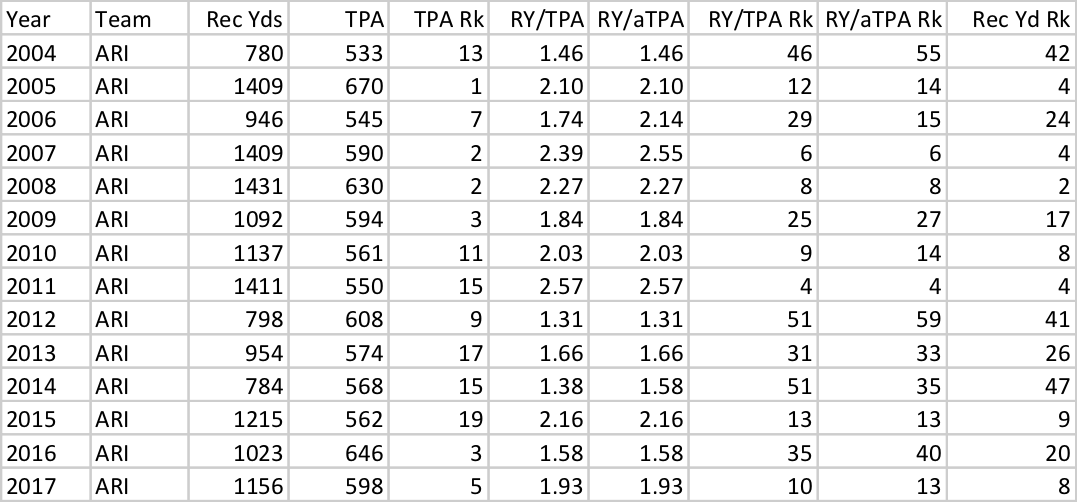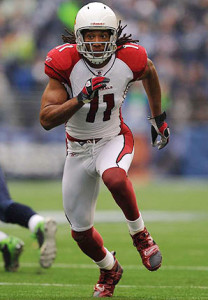From ages 21 to 25, Larry Fitzgerald was remarkable. In NFL history, only Randy Moss had more receiving yards over a player’s first five years in his 20s, and only Moss averaged more yards per game (minimum 50 games). Fitzgerald had three seasons with 1400+ yards before turning 26; Moss had two, and nobody else has had more than one.
But then, Fitzgerald’s career declined during his prime years, making him somewhat like the wide receiver version of Ken Anderson. In the post-Kurt Warner/pre-Carson Palmer era, Fitzgerald’s numbers tanked save for one outlier season in 2011 due to remarkable yards after the catch numbers. During the six seasons from ages 26 to 31 — the prime seasons for most wide receivers — Fitzgerald hit the 1,200 yard mark just once, during that 2011 season.
Thought of another way, of Fitzgerald’s six best seasons by receiving yards, five of them came outside of the 26-31 window. I looked at the 42 players with 10,000 receiving yards who have already played through their age 34 seasons. I then calculated their average production in each year from age 21 to 34 (whether they played in the NFL or not), to set a baseline average for each season. Then, I calculated their percentage of receiving yards at age X vs. their average level. That is in black below. I also included Fitzgerald’s production relative to his baseline in red and yellow.
As you can see, Fitzgerald was way more productive than even the average elite wide receiver in his early 20s. But at age 26 and 27 he was below-average, and then he was well below average at ages 29, 30, and 31. His production the last three years has been back in line with that of the average elite wide receiver, meaning he’s been right around his career average.

Here’s another way to think of it: Fitzgerald gained 6,176 receiving yards during his “prime years” from ages 26 to 31, and 7,180 in the three years before and after those prime years. From ‘2009 to 2014, Arizona ranked 26th in Net Yards per Attempt; meanwhile, from ’06 to ’08 the Cardinals ranked 6th in NY/A and then 12th over the last three years.
In some ways, this makes him similar to Charlie Joiner, who struggled during his prime years but etched out a Hall of Fame career. Fitzgerald is a better receiver than Joiner was, but if you start with a higher baseline, you can squint and see the career parallels.
The table below shows, for the 42 receivers identified above, their total receiving yards in their six prime seasons from age 26-31, their total receiving yards in the six surrounding seasons (SSS) from ages 23-25 and 32-34, and the difference. Only Joiner has a larger negative (i.e., better outside of his prime years) than Fitzgerald:
Fitzgerald actually gained fewer receiving yards during the six prime seasons than the average receiver on this list, but he had the second-most receiving yards during the six surrounding seasons. Football Perspective favorite Joey Galloway also makes an appearance near the top of the list, which won’t surprise regular readers.
What stands out to you?




